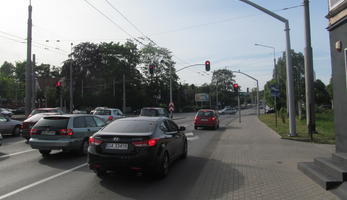Automatic traffic incident detection
Thematic areas
Smart, Sustainable, Connected and Shared mobility
- ITS-based enhancement of public transport
Summary
In Gdynia traffic flow is regularly hampered by traffic accidents. They disturb the traffic flow, cause disruptions and congestion, and as a consequence result in extra costs. To tackle this, Gdynia has developed an automatic traffic incident detection system that will be implemented at two junctions which were identified as the most dangerous.The expected result will be a 50% shorter time period of road incident detection and a 20% acceleration of rescue operation. Consequently, a significant shorter time period will be needed for re-establishment of the regular traffic organization and conditions after an incident.
Implementing sustainable mobility
Before DYN@Mo, there was no incident detection system in the City of Gdynia or in the region. Such systems are innovative in Poland and are only beginning to be implemented on motorways, but there was no such system on city streets in Poland yet.
Gdynia has been implementing an Intelligent Traffic Management System (ITS) TRISTAR system and an Intelligent Transport System with financial support from the Operational Programme Infrastructure and Environment. In 2012, a Traffic Management Centre was set up as the starting point for increased traffic safety.
Within this measure, junctions will be equipped with video camera-based detection systems. A pilot project for the 2 most dangerous junctions in the city will test the compatibility of the incident detection technology with ITS and choose the optimal technology. A research standpoint for simulation of road incidents detection is planned. The pilot project will be implemented in connection to the Traffic Management Centre in Gdynia which was set up in 2012.
The main objectives of this measure were:
- To Install a pilot automatic traffic incident detection system at two traffic hotspots in Gdynia
- Shortening the time of road accident detection by 50%
- Shortening the time of the rescue operation by 20%
- Decrease of number of fatalities in road accidents by 20%
- Improve traffic conditions due to shortening the time of rescue operation
Progress
The traffic incident detection system has been included within the TRISTAR system in several chosen areas: on roads with higher speed limit and on certain sections between junctions. The system has not been used at the city’s arteries with normal urban traffic conditions.
Planning & preparation
A feasibility study on the automatic incident detection study for the pilot project has been conducted by the Gdansk University of Technology. The geographical localisation of the pilot project was determined based on the statistical analysis of localisation, type and gravity of road incidents. Also, research standpoints for simulation of road incidents detection have taken place. Verification of algorithms of road incidents detection based on computer simulation and recommendation of algorithms for implementation has taken place.
Implementation & demonstration
During the implementation phase the following tasks were carried out or will be still carried out:
- Subcontracting the company that will elaborate the technical documentation of the pilot project
- Implementation of the pilot project under the supervision of Gdansk University of Technology
- Automatic traffic incident detection system will be installed at the most dangerous locations in Gdynia (chosen from the analysis conducted within CIVITAS-DYN@MO’s Community project studies from SUMP), using TRISTAR system components and devices
- The system will be operated from the standpoint located in the City of Gdynia
- Nominate personnel that will monitor the system and start monitoring
- Each road incident will be automatically registered for the operator of the system’s standpoint
- The system’s operator will verify the correctness of the incident registered and if needed will inform emergency services

Outcomes
Tangible outputs:
- Feasibility study of the traffic incident detection system
- Elaborated and tested documentation of procedures, technology and verified algorithms for further introduction of incident detection system
- Increased road safety – shortening of the time between road accidents and giving aid by 20%
- Increase of rescue operation efficiency
- Road safety analysis showing potential places for further implementation
Expected outcomes in the short- to medium-term:
- Pilot project will enable the choice of further developments of the system in the greater part of the city (if successful it may be spread to the entire city in the future)
Expected outcomes in the mid- to long-term:
- Practical case example for taking up such a system in other Polish cities
- Shortening the time of the rescue operation resulting in faster retaining normal traffic conditions







